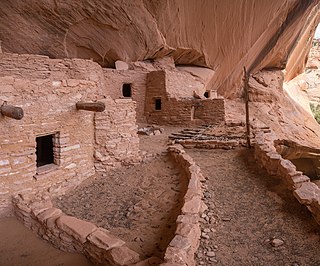
The Hopi are Native Americans who primarily live in northeastern Arizona. The majority are enrolled in the Hopi Tribe of Arizona and live on the Hopi Reservation in northeastern Arizona; however, some Hopi people are enrolled in the Colorado River Indian Tribes of the Colorado River Indian Reservation at the border of Arizona and California.

A kachina is a spirit being in the religious beliefs of the Pueblo people, Native American cultures located in the south-western part of the United States. In the Pueblo cultures, kachina rites are practiced by the Hopi, Hopi-Tewa and Zuni peoples and certain Keresan tribes, as well as in most Pueblo tribes in New Mexico.

Keams Canyon is a census-designated place (CDP) in Navajo County, Arizona, United States, on the Hopi Reservation. The population was 304 at the 2010 census.
Hopi is a Uto-Aztecan language spoken by the Hopi people of northeastern Arizona, United States.

Nampeyo was a Hopi-Tewa potter who lived on the Hopi Reservation in Arizona. Her Tewa name was also spelled Num-pa-yu, meaning "snake that does not bite". Her name is also cited as "Nung-beh-yong," Tewa for Sand Snake.

Navajo National Monument is a National Monument located within the northwest portion of the Navajo Nation territory in northern Arizona, which was established to preserve three well-preserved cliff dwellings of the Ancestral Puebloan people: Keet Seel, Betatakin, and Inscription House. The monument is high on the Shonto plateau, overlooking the Tsegi Canyon system, west of Kayenta, Arizona. It features a visitor center with a museum, three short self-guided trails, two small campgrounds, and a picnic area.

Jesse Walter Fewkes was an American anthropologist, archaeologist, writer, and naturalist.

The Hopi Reservation is a Native American reservation for the Hopi and Arizona Tewa people, surrounded entirely by the Navajo Nation, in Navajo and Coconino counties in northeastern Arizona, United States. The site has a land area of 2,531.773 sq mi (6,557.262 km2) and, as of the 2020 census had a population of 7,791.

Oraibi, also referred to as Old Oraibi, is a Hopi village in Navajo County, Arizona, United States, in the northeastern part of the state. Known as Orayvi by the native inhabitants, it is on Third Mesa on the Hopi Reservation near Kykotsmovi Village.
The Hopi-Tewa are a Tewa Pueblo group that resides on the eastern part of the Hopi Reservation on or near First Mesa in northeastern Arizona.

Fred Kabotie was a celebrated Hopi painter, silversmith, illustrator, potter, author, curator and educator. His native name in the Hopi language is Naqavoy'ma which translates to Day After Day.

Hopi Dictionary/Hopìikwa Lavàytutuveni: A Hopi–English Dictionary of the Third Mesa Dialect is a Hopi–English bilingual dictionary compiled by the Hopi Dictionary Project, a research team based at the Bureau of Applied Research in Anthropology at the University of Arizona. It was published in 1998 by the University of Arizona Press.

Charles Sequevya Loloma was a Hopi Native American artist known for his jewelry. He also worked in pottery, painting and ceramics.

Washington Matthews was a surgeon in the United States Army, ethnographer, and linguist known for his studies of Native American peoples, especially the Navajo.

Art of the American Southwest is the visual arts of the Southwestern United States. This region encompasses Arizona, New Mexico, and parts of California, Colorado, Nevada, Texas, and Utah. These arts include architecture, ceramics, drawing, filmmaking, painting, photography, sculpture, printmaking, and other media, ranging from the ancient past to the contemporary arts of the present day.

Faye Tso (1933–2004) was a Navajo potter and herbal medicine healer. Her pieces are known for their nontraditional imagery of corn maidens, warriors, and dancers, whereas Navajo pottery typically has little decoration. Born in Coal Mine Mesa, Arizona, Tso was relocated with other Navajos to Tuba City, Arizona in 1974 because of a land dispute between the Navajo and Hopi tribes. She returned to dig her clay at Coal Mine Mesa, where she also gathered pinon from which she extracted the pitch resin used to coat and seal her Dineh pottery. In 1990, the Arizona Indian Living Treasures Association designated Tso as a living treasure. Her husband and son are medicine men and use Tso's pots in their ceremonies.
Phillip Sekaquaptewa was a Hopi artist and silversmith in Hopi silver overlay and stone inlay, featuring the lapidary genres of commesso and intarsia. Sekaquaptewa used colorful stones and shell for his Hopi silver overlay, not only plain silver decorated with chisel strokes on black oxide surfaces, a Hopi-signature technique known as matting.
Nathan Begaye (1969–2010) was a Native American ceramics artist of Navajo and Hopi descent.
Grace Chapella (1874–1980) was a renowned Hopi-Tewa potter from a Tewa village and of the Bear Clan.

Albert Yava (1888–1980) was a Hopi–Tewa autobiographer and interpreter. Born in Tewa Village on First Mesa, Arizona, in 1888 to a Hopi father and a Tewa mother, Yava's given name was Nuvayoiyava, meaning Big Falling Snow. He attended primary school in Polacca, Arizona, at a time when compulsory education at US government-run schools was a controversial topic in the Hopi community. Teachers at the school shortened his name to Yava and added the familiar name Albert, both of which names he used for the remainder of his life. Yava subsequently attended boarding school in Keams Canyon, Arizona and spent five years at the Chilocco Indian School in Oklahoma.














